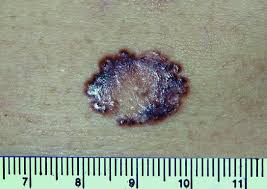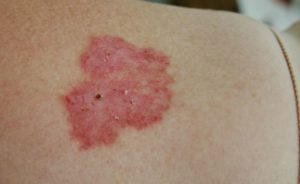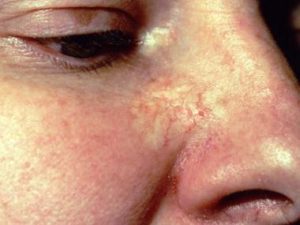
Basal cell carcinoma is a type of skin cancer. Basal cell carcinoma begins in the basal cells — a type of cell within the skin that produces new skin cells as old ones die off.
Most basal cell carcinomas are thought to be caused by long-term exposure to ultraviolet (UV) radiation from sunlight. Avoiding the sun and using sunscreen may help protect against basal cell carcinoma.
Causes
Basal cell carcinoma occurs when one of the skin’s basal cells develops a mutation in its DNA.
Basal cells are found at the bottom of the epidermis — the outermost layer of skin. Basal cells produce new skin cells. As new skin cells are produced, they push older cells toward the skin’s surface, where the old cells die and are sloughed off.
The process of creating new skin cells is controlled by a basal cell’s DNA. The DNA contains the instructions that tell a cell what to do. The mutation tells the basal cell to multiply rapidly and continue growing. Eventually the accumulating abnormal cells may form a cancerous tumor that appears on the skin.
Symptoms
Basal cell carcinoma usually develops on sun-exposed parts of your body, especially your head and neck. Less often, it can develop on parts of your body usually protected from the sun, such as the genitals.
Basal cell carcinoma appears as a change in the skin. These changes in the skin (lesions) usually have one of the following characteristics:
- A pearly white, skin-colored or pink bumpthat is translucent, meaning you can see a bit through the surface. Tiny blood vessels are often visible. In people with darker skin tones, the lesion may be darker but still somewhat translucent. The most common type of basal cell carcinoma, this lesion often appears on the face and ears. The lesion may rupture, bleed and scab over.

- A brown, black or blue lesion— or a lesion with dark spots — with a slightly raised, translucent border.

- A flat, scaly, reddish patch with a raised edge is more common on the back or chest. Over time, these patches can grow quite large.

- A white, waxy, scar-like lesionwithout a clearly defined border, called morpheaform basal cell carcinoma, is the least common.

When to see a doctor
Make an appointment with your doctor if you observe changes in the appearance of your skin, such as a new growth, a change in a previous growth or a recurring sore.
Prevention
To reduce your risk of basal cell carcinoma you can:
- Avoid the sun during the middle of the day.
- Wear sunscreen.Use a broad-spectrum sunscreen with an SPF of at least 30, even on cloudy days. Apply sunscreen generously, and reapply every two hours — or more often if you’re swimming or perspiring.

- Wear protective clothing.Cover your skin with dark, tightly woven clothing that covers your arms and legs, and a broad-brimmed hat, which provides more protection than does a baseball cap or visor. Don’t forget sunglasses. Look for those that block both types of UV radiation — UVA and UVB rays.
- Avoid tanning beds.
- Check your skin regularly and report changes to your doctor.